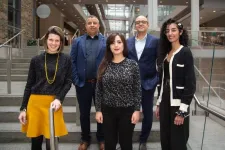(Press-News.org) Competition between species played a major role in the rise and fall of hominins – and produced a “bizarre” evolutionary pattern for the Homo lineage – according to a new University of Cambridge study that revises the start and end dates for many of our early ancestors.
Conventionally, climate is held responsible for the emergence and extinction of hominin species. In most vertebrates, however, interspecies competition is known to play an important role.
Now, research shows for the first time that competition was fundamental to “speciation” – the rate at which new species emerge – across five million years of hominin evolution.
The study, published today in Nature Ecology & Evolution, also suggests that the species formation pattern of our own lineage was unlike almost anything else.
“We have been ignoring the way competition between species has shaped our own evolutionary tree,” said lead author Dr Laura van Holstein, a University of Cambridge biological anthropologist from Clare College. “The effect of climate on hominin species is only part of the story.”
In other vertebrates, species form to fill ecological “niches” says van Holstein. Take Darwin’s finches: some evolved large beaks for nut-cracking, while others evolved small beaks for feeding on certain insects. When each resource niche gets filled, competition kicks in, so no new finches emerge and extinctions take over.
Van Holstein used Bayesian modelling and phylogenetic analyses to show that, like other vertebrates, most hominin species formed when competition for resources or space were low.
“The pattern we see across many early hominins is similar to all other mammals. Speciation rates increase and then flatline, at which point extinction rates start to increase. This suggests that interspecies competition was a major evolutionary factor.”
However, when van Holstein analysed our own group, Homo, the findings were “bizarre”.
For the Homo lineage that led to modern humans, evolutionary patterns suggest that competition between species actually resulted in the appearance of even more new species – a complete reversal of the trend seen in almost all other vertebrates.
“The more species of Homo there were, the higher the rate of speciation. So when those niches got filled, something drove even more species to emerge. This is almost unparalleled in evolutionary science.”
The closest comparison she could find was in beetle species that live on islands, where contained ecosystems can produce unusual evolutionary trends.
“The patterns of evolution we see across species of Homo that led directly to modern humans is closer to those of island-dwelling beetles than other primates, or even any other mammal.”
Recent decades have seen the discovery of several new hominin species, from Australopithecus sediba to Homo floresiensis. Van Holstein created a new database of “occurrences” in the hominin fossil record: each time an example of a species was found and dated, around 385 in total.
Fossils can be an unreliable measure of species’ lifetimes. “The earliest fossil we find will not be the earliest members of a species,” said van Holstein.
“How well an organism fossilises depends on geology, and on climatic conditions: whether it is hot or dry or damp. With research efforts concentrated in certain parts of the world, and we might well have missed younger or older fossils of a species as a result.”
Van Holstein used data modelling to address this problem, and factor in likely numbers of each species at the beginning and end of their existence, as well as environmental factors on fossilisation, to generate new start and end dates for most known hominin species (17 in total).
She found that some species thought to have evolved through “anagenesis” – when one slowly turns into another, but lineage doesn’t split – may have actually “budded”: when a new species branches off from an existing one.*
This meant that several more hominin species than previously assumed were co-existing, and so possibly competing.
While early species of hominins, such as Paranthropus, probably evolved physiologically to expand their niche – adapting teeth to exploit new types of food, for example – the driver of the very different pattern in our own genus Homo may well have been technology.
“Adoption of stone tools or fire, or intensive hunting techniques, are extremely flexible behaviours. A species that can harness them can quickly carve out new niches, and doesn’t have to survive vast tracts of time while evolving new body plans,” said van Holstein
She argues that an ability to use technology to generalise, and rapidly go beyond ecological niches that force other species to compete for habitat and resources, may be behind the exponential increase in the number of Homo species detected by the latest study.
But it also led to Homo sapiens – the ultimate generalisers. And competition with an extremely flexible generalist in almost every ecological niche may be what contributed to the extinction of all other Homo species.
Added van Holstein: “These results show that, although it has been conventionally ignored, competition played an important role in human evolution overall. Perhaps most interestingly, in our own genus it played a role unlike that across any other vertebrate lineage known so far.”
Notes:
*For example, the hominin species Australopithecus afarensis was believed to have speciated via anagenesis from Australopithecus anamensis. However, the new data modelling suggests they overlapped by around half a million years.
END
Interspecies competition led to even more forms of ancient human – defying evolutionary trends in vertebrates
2024-04-17
ELSE PRESS RELEASES FROM THIS DATE:
First new analysis in three decades identifies which treatments for the long-term effects of malnutrition could help reduce mortality and poor health outcomes for children
2024-04-17
A comparison of treatments for malnutrition enteropathy, caused by severe acute malnutrition (SAM), has found evidence supporting the use of treatments to enhance the healing of mucosal membranes and reduce inflammation in the gut to improve the outcomes of children affected by long-team health consequences of a period of malnutrition.
The Therapeutic Approaches to Malnutrition Enteropathy (TAME), led by researchers from Queen Mary University of London, evaluated four interventions for malnutrition enteropathy in a multi-centre phase ...
AI speeds up drug design for Parkinson’s by ten-fold
2024-04-17
Researchers have used artificial intelligence techniques to massively accelerate the search for Parkinson’s disease treatments.
The researchers, from the University of Cambridge, designed and used an AI-based strategy to identify compounds that block the clumping, or aggregation, of alpha-synuclein, the protein that characterises Parkinson’s.
The team used machine learning techniques to quickly screen a chemical library containing millions of entries, and identified five highly potent compounds for further investigation.
Parkinson’s affects more than six million people worldwide, with that number projected to triple by 2040. ...
Older adults with diabetes experienced functional decline during the COVID-19 pandemic
2024-04-17
Toronto, ON —Researchers found that approximately 1 in 5 older Canadian adults with diabetes and no pre-pandemic functional limitations developed functional limitations for the first time during the COVID-19 pandemic. Functional limitations refer to difficulties with basic mobility-related tasks, such as walking two to three blocks, standing up from a chair, or climbing stairs. In comparison, only one in eight of their peers without diabetes developed functional limitations during the ...
How soil microbes survive in harsh desert environments
2024-04-17
Prolonged droughts followed by sudden bursts of rainfall – how do desert soil bacteria manage to survive such harsh conditions? This long-debated question has now been answered by an ERC project led by microbiologist Dagmar Woebken from the Centre for Microbiology and Environmental Systems Science (CeMESS) at the University of Vienna. The study reveals that desert soil bacteria are highly adapted to survive the rapid environmental changes experienced with each rainfall event. These findings were recently published in the prestigious ...
Toronto researchers uncover human DNA repair by nuclear metamorphosis
2024-04-17
Researchers at the University of Toronto have discovered a DNA repair mechanism that advances understanding of how human cells stay healthy, and which could lead to new treatments for cancer and premature aging.
The study, published in the journal Nature Structural and Molecular Biology, also sheds light on the mechanism of action of some existing chemotherapy drugs.
“We think this research solves the mystery of how DNA double-strand breaks and the nuclear envelope connect for ...
Fluctuating coffee prices put mental pressure on Vietnamese farmers
2024-04-17
While your invigorating morning coffee may become cheaper when there are large fluctuations in the world market price, they are a major additional psychological burden for the farmers who grow the coffee.
This is documented in a new international study on the effect of income uncertainty on the mental health of Vietnamese coffee farmers.
"Our results suggest that not only poverty, but also the risk of poverty caused by fluctuating prices has a significant additional negative effect on the mental well-being of farmers in low-income countries," says Finn ...
Silver-based micromotors that eliminate bacteria moving freely in aqueous media
2024-04-17
In ancient Greece, over 3000 years ago, wise men used silver salts to prevent wounds from becoming infected. These salts continued to be used until Alexander Fleming discovered the first antibiotic "just" 100 years ago. The use of antibiotics represented a major breakthrough in the treatment of infectious diseases, but resistance soon began to emerge. Bacteria, which have been on the planet longer than us, have found ways to overcome different antibiotics, and today antibiotic resistance is a major global health problem.
In times when everything evolves ...
New research shows urgency to act on Nigeria’s trans fat elimination policy
2024-04-17
Significantly reducing trans fat levels in the Nigerian food supply could prevent approximately 10,000 heart disease deaths and save 90 million USD (12 billion Naira, ₦) in healthcare costs over a decade. New findings by The George Institute for Global Health on the health and economic benefits of enacting the country’s trans fat elimination policy were published today in BMJ Global Health.
In 2023, Nigeria followed South Africa as only the second African country to adopt a best practice trans fat ...
Healthy diet lowers heart disease risk in breast cancer survivors
2024-04-17
A new paper in JNCI Cancer Spectrum, published by Oxford University Press, finds that following a healthy diet lowers the risk of cardiovascular disease in breast cancer survivors.
Cardiovascular disease is the top non-breast cancer related cause of death in women with breast cancer. There are more than 3.8 million female breast cancer survivors in the United States. These women are at higher risk for cardiovascular disease than women who have not had breast cancer. This is likely due to the cardiotoxic effects of breast cancer treatment, as well as common risk factors for both breast cancer and cardiovascular disease, such as aging, lack of exercise, ...
From defects to order: Spontaneously emerging crystal arrangements in perovskite halides
2024-04-17
Perovskites are among the most extensively studied materials in modern materials science. Their often unique and exotic properties, which stem from perovskite’s peculiar crystal structure, could find revolutionary applications in various cutting-edge fields. One intriguing way of realizing such properties is through the precise ordering of a perovskite’s defects, such as vacancies or substitutions.
In oxide chemistry, scientists have known for a long time that oxide defects can spontaneously and consistently arrange themselves throughout the crystal lattice, once they reach certain concentrations (e.g. integer ratio). This emerging ...






